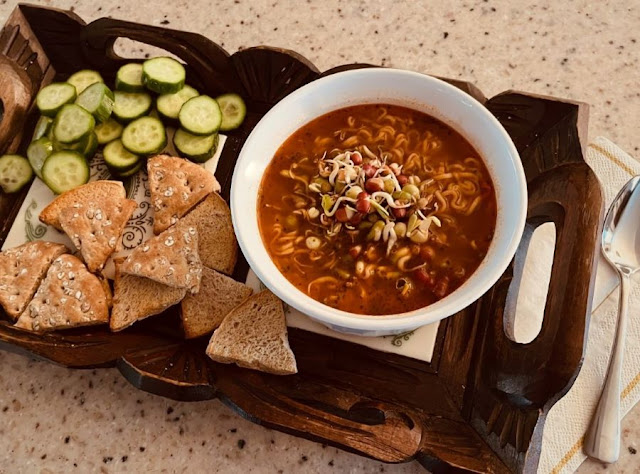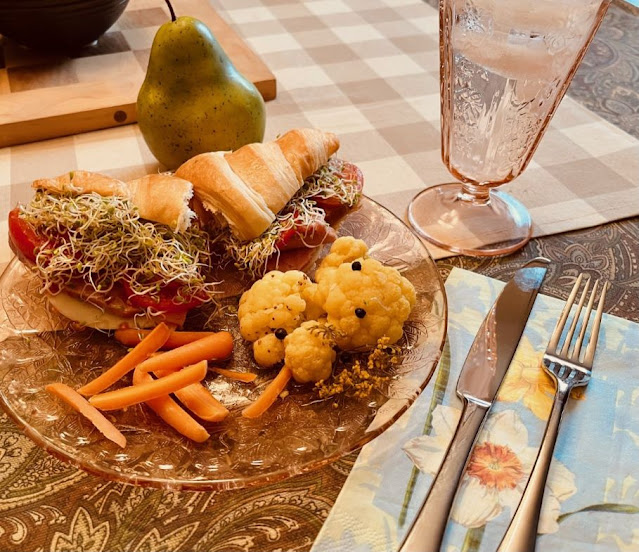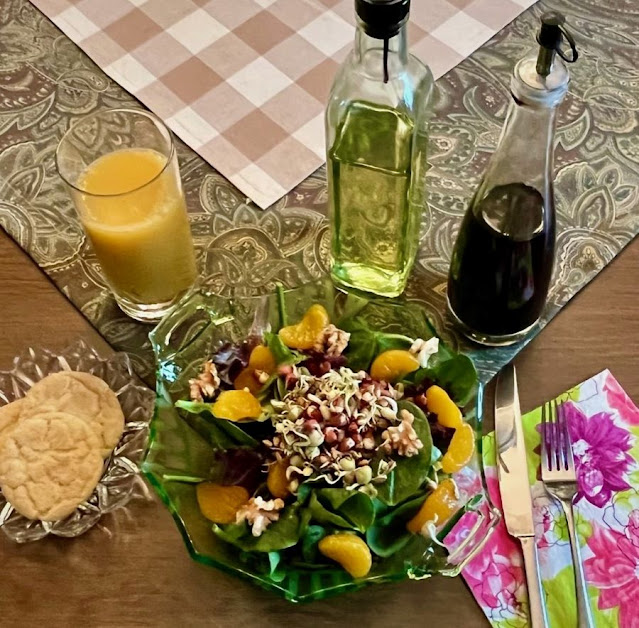Hello Friends,
Sprouts are the germinated seeds, young plants on their way to full growth. They provide great nutrition, flavor and crunchy texture to salads, soups, sandwiches and dips.
You can find sprouts in grocery stores and farmers markets. Sprouting at home is easy, economical and a fun project to satisfy that gardening bug when the weather isn't agreeable to gardening outside.
I use organic seeds from reliable sources ready for food safe sprouting. You can find wide varieties of great seeds at some bulk food stores or on line sites. I keep an assortment of single variety and mixes - Mung beans, alfalfa, adzuki, cabbage, chives, red clover, beet, fenugreek, garbanzo, lentil, mustard, peas, radish, wheat and black sunflower. Find a supplier that offers a variety starter pack so you can try various sprouts and determine your flavor favorites - mild, peppery, spicy, crunchy, colorful - quality suppliers will offer the information on each type.
It is important to follow good hygiene practices. Be sure to clean all equipment with hot soapy water or run them through the dishwasher and of course, clean hands and work area are important.
You can make your own sprouting jars with fine mesh screens, cheesecloth, plastic canvas or even punching holes in a metal lid. I have lids that fit wide mouth canning jars. During the sprouting process you want to keep the jars upside down with raised lids or on an angle so any excess moisture drains off. Using quart canning jars are good because they are long and wide giving lots of room for the seeds to sprout with air circulation. Avoid a small jar where all the seeds are cramped together.
In you use clean quart jars, place one to two tablespoons of seeds in the jars. If you want more you will need larger jars. To start, rinse the seeds well and drain. Then cover the seeds with about 2 inches of room temp water. You always want to use room temp water, too hot or too cold may cause issues.
The seeds need to be soaked in water for about 8 to 12 hours first to hydrate the seeds and encourage the start of the germination process. After the first soak, keep the jars in a light and airy spot during the sprouting process, but not in direct sunlight. Sprouting works best somewhere cool and with consistent light levels, such as a north facing window sill or counter out of the sun.
Multi grain bread, grilled chicken breast, tomatoes, onion and alfalfa sprouts with a side of pickle.
Once you’ve soaked your seeds, rinse and drain them several times. Then you will rinse and drain them 2-3 times a day to keep them moist but not wet. It is important that you rinse and drain your sprouts frequently to help avoid bacteria build-up. Growing sprouts should be kept at cool room temps of 65 to 70 degrees because the temperature needs to be high enough to encourage germination, but not too high to cause bacteria or mold to grow.
Note how the seeds are distributed along the sides of the jar. This keeps them from bunching up together at the bottom which allows good air circulation and avoids problems with too much moisture causing the seeds to spoil. The jar that is tilted contains larger peas and beans so they don't stick to the sides of the jar so I shake it to spread them out as best I can and store tilted. I do this each time I rinse and drain - 3 times a day.
Keep the seeds relatively spread out by shaking the jar allow the seeds to spread out and allow good airflow. When draining, be sure to shake and tap your container to remove as much excess water as possible and spread the seeds around the surface of the jar.
Day two, sprouts are germinating. 2 tablespoons of seeds like alfalfa, clover, broccoli can yield the quart jar filled while large legumes like peas, beans and lentils will sprout and expand a little but not fill the jar.
Home-grown sprouts such as peas, beans and lentils will be ready to eat in around 3 to 4 days, when a small shoot is just visible. Sprouts such as alfalfa, clover, beets, broccoli or radish are generally harvested when about an inch long and will be ready to eat in around 4 to 6 days. You can test the sprouts through the process to see the stage you like best. If you prefer the sprouts to "green up" a little you can provide brighter light on the last day or so. You can allow the first tiny "leaves" to develop before harvest but don't let them go too long, just test them to see what you like best.
To harvest, give the sprouts a final rinse and drain thoroughly on muslin, tea towel or paper towels. Then, put them in a salad spinner or pat them dry before transferring them to the fridge. I like to store them in glass dishes with tightly sealed lids. Sprouts should not be stored wet.
Home-grown sprouts that are ready to eat will last up to five days if properly stored in the refrigerator. If your sprouts start to discolor, look brown, or smell off they should be discarded.
Spring mix orange walnut salad with lentil, adzuki, pea & mung bean sprouts, simply dressed with balsamic, olive oil, sea salt and cracked peppercorns. Snickerdoodles, too.
I hope you'll give sprouting a try, easy, delicious and nutritious.
Thanks for visiting,
Bonnie
From the Cleveland Clinic:
"What are the benefits of sprouts?
Sprouts are jam-packed with vitamins and minerals, varying from sprout to sprout. Sprouts carry essential vitamins, minerals, fiber and are a great source of antioxidants. For instance, Broccoli sprouts will be loaded with vitamin A, vitamin C, vitamin K, folic acid and they are a really good source of the powerful antioxidant sulforaphane. Sprouts can also carry other nutrients like B vitamins and minerals like phosphorus and magnesium. Plus, they’re low in things like fat, sodium and calories.
There’s also the appeal of what they can bring to your meal. They bring a variety to your salad, wrap or sandwich, They can add a crunch and even a different flavor besides those health benefits. And that makes them appealing to a lot of people."















No comments:
Post a Comment